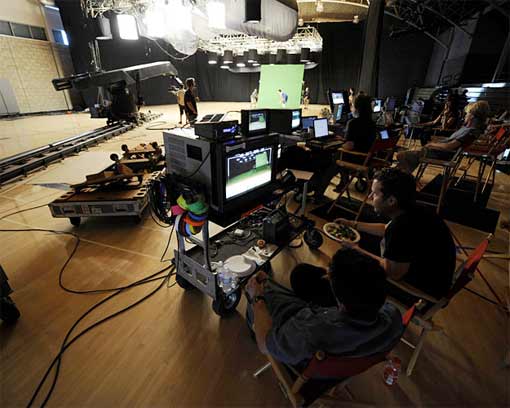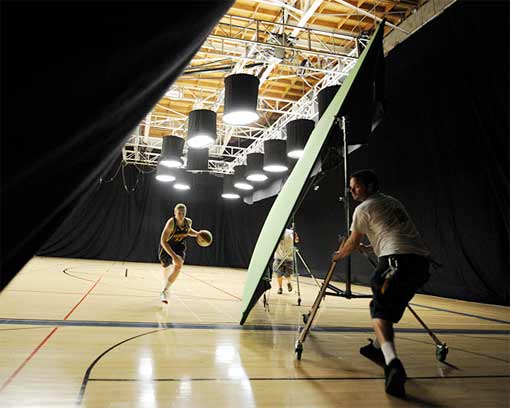With Roto and Paint, Stardust Studios Does the Tournament in Real Time

Watch the spot, below, then read our Q&A with Banks and Ashton for background info.
Jake Banks: Basically the agency came to us with this idea of starting from 8 and going down to 1. That’s the whole concept of the campaign, so they were trying to figure out how to best tell the story of elimination throughout the playoffs. They had this initial idea that evolved into a very choreographed, motion-controlled, highly composited VFX piece. But the whole idea was to make it feel like it wasn’t a VFX piece. Make it feel more in-camera, with realistic lighting. We wanted to make the characters feel really planted in reality. And when one player wipes the other off the screen, it’s not a big explosion or anything like that. It’s very subtle and clean.
And you knew you were going to be using real players right from the start?
JB: Yes. The biggest thing is we don’t know who the players are going to be. We’re compositing these as players are being eliminated. We basically had to shoot every player at every position. Eight players at the top would be in the playoffs, and then four would be in the next tier of the playoffs. When it’s all said and done and we determine who the winner of the playoffs is, we’ll have one player at the very end. So we’re evolving it as the playoffs go on.
Andrew Ashton: Certainly one of the bigger challenges was making sure that we filmed it in a way that was modular. There were 14 different teams in the competition. That meant we had to shoot a little over 100 set-ups in two days, shooting each player in each possible position doing the choreographed move.
Was it tricky to figure out exactly how to approach the shoot?
AA: We tried to foresee all the possible problems in our different setups, and it worked out quite well. We ran a green-screen flag behind the players so we could key and roto them out, but it made sure that every pass and every shot had the same lighting as the environment. Each element was separated and then composited all together. No two elements in the spot actually came from the same shot, but the fact that we kept everything in the gymnasium that we shot it really maintained all the lighting. Everyone really felt like they were in the scene.
We shot different clean plates of the floor, because it was all motion control, and different passes of the lights overhead. Our roto and paint crew did a lot of clean-up. We were able to have all the women separate and composite them all together.

Photo: Matt Brown/NBAE/Getty Images
Looking at a low-res QuickTime of the spot, I thought maybe you shot on a green-screen stage, and created the gym as a virtual environment.
SIMULTANEOUSLY: No, no!
AA: That was all real.
JB: The lights that we shot were all part of the set. Our production crew set up the lights, blacked out the walls of the gym.
AA: We wanted to set up this infinite space going back into the darkness, so we really controlled the lighting in the center of the court and blacked out everywhere else. What you see was captured in camera, shot from two different motion-control moves on different passes.
How did the motion-control shoot go?
AA: We worked with Camera Control (Santa Monica, CA) on that. They were great to work with. We did a little pre-vis work before hand to make sure the dimensions of the court and the camera move we needed to do would give us enough distance to pull back with the length of the tracks. That panned out perfectly on set. The Camera Control guys were able to program the move in the morning and repeat that constantly for the next two days.
We did some track-removal passes on one of the longer pull-backs. We had a track in the foreground, so we did a second take of that with one of the tracks removed and then spliced the floors together to create a clean plate.

Photo: Matt Brown/NBAE/Getty Images
It must have been interesting to choreograph the movements of the players.
AA: One of the other challenges was the time schedule to coordinate and work with all 14 team representatives at different times throughout the two days. We mapped out each move on the floor with markings so it was a path they could follow so it was easy to bring them on set, put them in position, and say, “This is what you need to follow.” We used stopwatches to make sure everyone hit their marks at specific times. And it all fit together properly.
Were the reflections in the surface of the floor in-camera or VFX?
AA: They were a post reflection and shadow that was done to match the live action ones. We had to recreate them because our floor was separate and we had to do a lot of painting to change the floor from the original. The natural reflections crossed through a lot of the different markers we had taped on the floor, and so forth, so we created CG reflections to match the originals.
Talk about the post process.
AA: Well, we shot with the Sony F900. The HD really worked well for us as we could bring it in and edit it in-house. We had a roto-and-paint team set up about 10 people strong, roto’ing out a lot of different plates, including a lot of plates that never made it to the spot. It was all composited finally in Shake and final output through After Effects. We built everything at HD. The final delivery was SD, but we worked all the way through at HD, which gave us the resolution to shuffle and move things around quite nicely.
And the compositing for subsequent versions of this as the tournament progresses will be done on the fly?
AA: Yes. We’re in that process in the moment, working on some different ways to show the final eight disappearing, getting whittled down, as the tournament progresses. We’re constantly watching the standings online to anticipate which players and which teams we need to be working on. That’s been the case all the way through. For the elimination side of things, the schedule is certainly tightening up – we’ll have a two- or three-day turnaround.
What was the most challenging aspect of the shoot?
JB: The time crunch. Basically, we had two hours with each player. We had to set up the lighting and the motion-control rig, and these players had to get on planes. They have a full schedule. We had to really rush. That was the most challenging moment.
They’re obviously on TV and in the spotlight all the time, but were they comfortable with giving this kind of performance?
AA: That was one thing we were wondering about. But they were definitely comfortable. You get them on the court, and they move just how you’d expect them to. There wasn’t a huge amount required as far as controlling the way they were dribbling, so that helped us out a lot.
Is it unusual to be working on this kind of schedule, changing the elements of a piece as teams or players are eliminated from a competition?
JB: Yes, it’s pretty unusual. I’ve never had to do a real-time commercial before!
For more on the production, visit www.wnba.com/expectgreat/. For more information on Stardust Studios, visit www.stardust.tv.
WNBA “From 8 to 1”
First aired: 9/4/08
Location: Colin L. Powell Academy Gymnasium, Long Beach, CA.
Agency: Goodby, Silverstein & Partners, San Francisco
Partner/Creative Director: Jamie Barrett
Group Creative Directors: Chris Ford, Ari Weiss
Art Director: Adrien Bindi
Agency Producers: Ashley Sferro, Jake Grand
Production Company: Stardust Studios, Santa Monica/NY
Director: Jake Banks
Executive Producer: Paul Abatemarco
Director of Photography: Jaron Presant
VFX Supervisor: Andrew Ashton
Editor: Tony Hall
3D Artists: Kevin Ta, Mike Cahill
Line Producer: Rich Kaylor
Post Producer: Megan Kennedy
Online Editor: Michael Merkwan
Final Mix: Dave Baker, Crescendo Studios, San Francisco
Did you enjoy this article? Sign up to receive the StudioDaily Fix eletter containing the latest stories, including news, videos, interviews, reviews and more.








